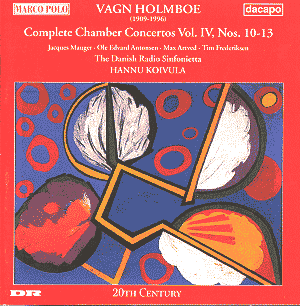| Vagn HOLMBOE (1909-96) Chamber Concertos - Vol. 4 No. 10 for wood-brass-gut and orchestra (1945-46) No. 11 for trumpet and chamber orchestra (1948) No. 12 for trombone and orchestra (1950) No. 13 for oboe, viola and chamber orchestra (1955-56) Ole Edvard Antonsen (trumpet) Max Artved (oboe) Tim Frederiksen (viola) Danish Radio Sinfonietta/Hannu Koivula rec Aug, Nov 1997 Crotchet AmazonUK AmazonUS Amazon recommendations |
 |
This is the concluding disc presenting the complete run of Holmboe's chamber concertos. These works evince Holmboe's confidence, unshaken by doubts and it is notable that after 1956 Holmboe bade farewell to the medium, having written thirteen examples, and moved onwards.
The textures of the Wood-Brass-Gut Concerto are roughened and the whole work has a Sibelian élan - a sense of exuberance perhaps associated with the end of the Second World War. In fact this 1945 piece is the most Sibelian of all the chamber concertos although the Viola Concerto makes it a close run thing. Uproar and joy erupt in these two works. Holmboe's strong Scandinavian orientation points to a composer I could not ever imagine departing for the sunnier and affluent climes of California though no doubt people did try to enlist him for the 'Blue Skies' universities.
The Concerto's unresting activity suggests the lyrical intoxication of Tippett which, if not offset, might have taken us into the singing lines of the Estonian symphonist Adolfs Skulte. Holmboe's characteristic stamping impacts should be seen in the context of Jon Leifs, Rosenberg and, up to a point, John Fernstrom. He taps into Nielsen once again and into that same sense of joy uncapped found in Beethoven's Seventh and de Falla's Tricorne.
The Trumpet Concerto is from a more complicated world where the soloist's chanting oration represents the spirit: bloodied but unbowed. The echoes of Hovhaness (you can hardly evade them in a work for trumpet and orchestra) are also there. In the middle movement we come to what amounts to a Nordic spiritual. The work wraps up with Shostakovich-accented staccato figuration for the solo instrument over scurrying strings.
The Trombone Concerto speaks from the same manual as Robert Simpson with his Beethovenian hat on (try Symphony No. 4 and the central string quartets). While there are cheeky Nielsen-like rolls and slides Holmboe allows the trombone to be the singer too.
Finally the Oboe and Viola Concerto is also a work of singing propensity. It is ushered in by a very cold front where the viola's voice is matched up to the oboe. The gentle middle movement is a counterpart to the Malcolm Arnold Oboe Concerto with Sibelian rustlings and small stirrings of icy wind from the strings: Moeran meets Frank Bridge. The work concludes rather roughly to my mind.
We have encountered Max Artved (oboe) and Tim Frederiksen (viola) in the earlier volumes. Jacques Mauger (trombone) and Ole Edvard Antonsen (trumpet) are new to us. They prove as articulate as the other soloists and demonstrate Holmboe's singing caprice against the bluffer natural qualities of their instruments. In no case, across these four discs, was I left in awe of pyrotechnic display. These are just not that sort of works. They have their flighty and virtuosic moments but all thirteen impress for their dialogue, their 'meat' and interaction with the orchestra of which the soloists are the principals. The chamber qualities of conversational interplay and psychological counterpointing are surely accomplished with more conviction and sincerity than would have been possible if celebrity soloists had been 'shipped in'.
All in all a lovingly put together project which will reward long term listening as well as dipping and sampling.
Rob Barnett